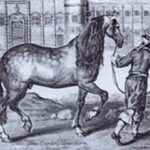Also known as the Metis Trotter, this breed is one of the most popular harness racing breeds in modern Russia. Although Russia was blessed with the extraordinary Orlov Trotter, this stylish breed lacked the sheer speed of the American Standardbred. So, Russian horse breeders decided to put a Russian twist to the American breed.
Brief History
Starting in 1890, they began importing American Standardbred breeding stock, which stopped with the Revolution. “International Encyclopedia of Horse Breeds” (Bonnie Hendricks, 1995) estimates that 220 Standardbred mares and 156 stallions in all were imported and crossed with Orlov Trotters.
One of the first successful racing trotters of this new cross was a mare named Kleopatra, who trotted the mile in a then stunning time of 2.17 minutes and earned an even more stunning 92,000 rubles in her career. She raced around 1910. Her sire was the Standardbred Prince Varvik and her dam was an Orlov Trotter named Kralia.Once the Communists realized they were in power, they set about implementing livestock breeding programs, including programs for Russian Trotters. Although the breed was considered fixed in 1950, with foals predictably looking and behaving like their parents, another wave of American Standardbreds were imported in the 1960’s, including Lowe Hanover and Reprise.
There are some who believe that Clever Hans, a horse once thought to be a mind reader, was a Russian Trotter, but others claim he was an Orlov and still others state he was an Arabian. He was probably a crossbred, but who knows. But there is a case to be made that he was a Russian Trotter. Russian Trotters are generally horses who like to please.Today, the Russian Trotter’s studbook is kept by the All-Russian Institute of Horsebreeding located in Ryazan. The studbook is still open to purebred American Standardbreds.
Racing Concerns
Since 1990 and the rise of capitalism in the former USSR, wealthy sportsmen have been buying some of the best Standardbred bloodlines and wiping out all of the Russian competition with them. It is now thought that the average Russian Trotter is more American than Russian, so the breed is facing extinction.It is extremely difficult to tell any difference between a Standardbred and a Russian Trotter, but there usually are differences in the head. A Standardbred’s ears are generally longer, the eyes are smaller and the head often muleish or slightly ram-headed. The neck is also shorter.
However, there is a great variety in Standardbreds, so some do have the pretty heads and longer necks of a Russian Trotter.There are just as many problems in the harness racing world of Russia as in America. Basically, what do you do with the horses when they are retired from racing? Only a small percentage goes into breeding. The majority are usually slaughtered for meat. A lucky few get to have a second career as a riding horse or farm horse.
References:
“International Encyclopedia of Horse Breeds.” Bonnie Hendricks. University of Oklahoma Press; 1995
Wikipedia. “Clever Hans.” http://en.wikipedia.org/wiki/Clever_Hans
VINK. “All Russian Institute of Horse Breeding.” http://www.maakcenter.org/ENG/vniik.html
YouTube “Klarnet (Russian Trotter.)” http://www.youtube.com/watch?v=_SOBL4mPRms



